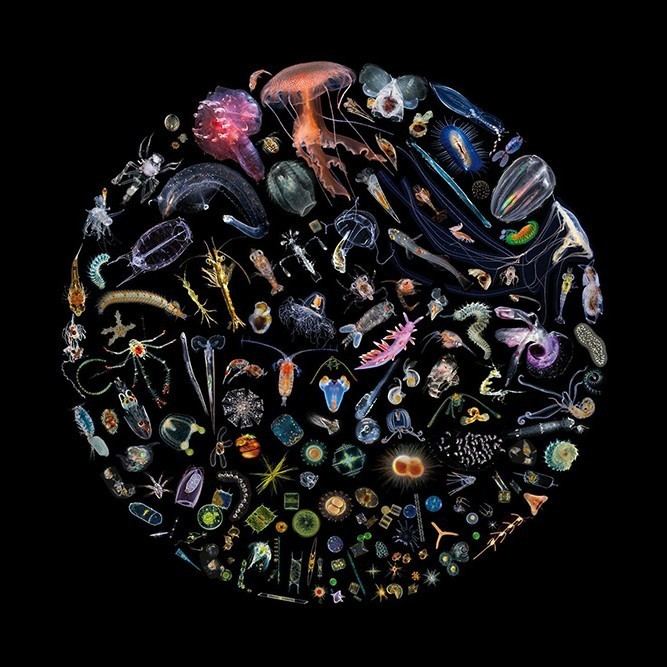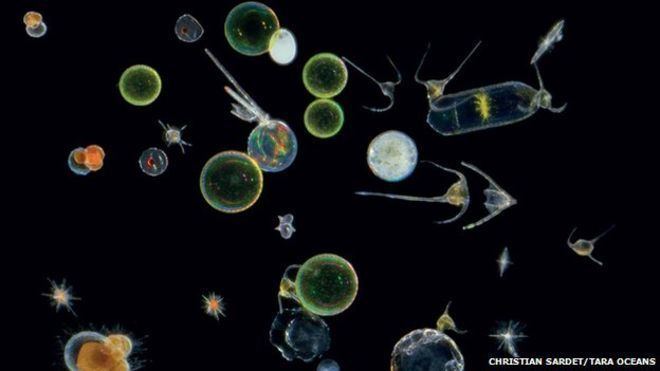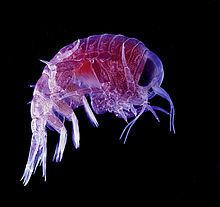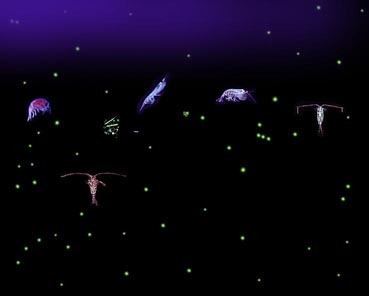 | ||
The secret life of plankton
Plankton (singular plankter) are the diverse collection of organisms that live in the water column of large bodies of water and are unable to swim against a current. They provide a crucial source of food to many large aquatic organisms, such as fish and whales.
Contents
- The secret life of plankton
- Plankton eating plastic caught on camera for the first time
- Terminology
- Trophic groups
- Size groups
- Distribution
- Food chain
- Carbon cycle
- Oxygen production
- Biomass variability
- Importance to fish
- References
These organisms include bacteria, archaea, algae, protozoa and drifting or floating animals that inhabit, for example, the pelagic zone of oceans, seas, or bodies of fresh water. Essentially, plankton are defined by their ecological niche rather than any phylogenetic or taxonomic classification.

Though many planktonic species are microscopic in size, plankton includes organisms covering a wide range of sizes, including large organisms such as jellyfish.

Plankton eating plastic caught on camera for the first time
Terminology

The name plankton is derived from the Greek adjective πλαγκτός (planktos), meaning errant, and by extension "wanderer" or drifter. It was coined by Victor Hensen (1887). Plankton typically flow with ocean currents. While some forms are capable of independent movement and can swim hundreds of meters vertically in a single day (a behavior called diel vertical migration), their horizontal position is primarily determined by the surrounding currents. This is in contrast to nekton organisms that can swim against the ambient flow and control their position (e.g. squid, fish, and marine mammals).

Within the plankton, holoplankton spend their entire life cycle as plankton (e.g. most algae, copepods, salps, and some jellyfish). By contrast, meroplankton are only planktic for part of their lives (usually the larval stage), and then graduate to either a nektic or benthic (sea floor) existence. Examples of Meroplankton include the larvae of sea urchins, starfish, crustaceans, marine worms, and most fish.
Plankton abundance and distribution are strongly dependent on factors such as ambient nutrient concentrations, the physical state of the water column, and the abundance of other plankton.
The study of plankton is termed planktology and a planktonic individual is referred to as a plankter.
The adjective planktonic is widely used in both the scientific and popular literature, and is a generally accepted term. However, from the standpoint of prescriptive grammar the less commonly used planktic is more strictly the correct adjective. When deriving English words from their Greek or Latin roots the gender specific ending (in this case "-on," which indicates the word is neuter) is normally dropped, using only the root of the word in the derivation.
Trophic groups
Plankton are primarily divided into broad functional (or trophic level) groups:
This scheme divides the plankton community into broad producer, consumer and recycler groups. However, determining the trophic level of some plankton is not straightforward. For example, although most dinoflagellates are either photosynthetic producers or heterotrophic consumers, many species are mixotrophic depending upon circumstances.
Size groups
Plankton are also often described in terms of size. Usually the following divisions are used:
However, some of these terms may be used with very different boundaries, especially on the larger end. The existence and importance of nano- and even smaller plankton was only discovered during the 1980s, but they are thought to make up the largest proportion of all plankton in number and diversity.
The microplankton and smaller groups are microorganisms and operate at low Reynolds numbers, where the viscosity of water is much more important than its mass or inertia.
Distribution
Plankton inhabit oceans, seas, lakes, ponds. Local abundance varies horizontally, vertically and seasonally. The primary cause of this variability is the availability of light. All plankton ecosystems are driven by the input of solar energy (but see chemosynthesis), confining Primary production to surface waters, and to geographical regions and seasons having abundant light.
A secondary variable is nutrient availability. Although large areas of the tropical and sub-tropical oceans have abundant light, they experience relatively low primary production because they offer limited nutrients such as nitrate, phosphate and silicate. This results from large-scale ocean circulation and water column stratification. In such regions, primary production usually occurs at greater depth, although at a reduced level (because of reduced light).
Despite significant macronutrient concentrations, some ocean regions are unproductive (so-called HNLC regions). The micronutrient iron is deficient in these regions, and adding it can lead to the formation of blooms of many kinds of Phytoplankton. iron primarily reaches the ocean through the deposition of dust on the sea surface. Paradoxically, oceanic areas adjacent to unproductive, arid land thus typically have abundant phytoplankton (e.g., the eastern Atlantic Ocean, where trade winds bring dust from the Sahara Desert in north Africa). While plankton are most abundant in surface waters, they live throughout the water column. At depths where no primary production occurs, Zooplankton and bacterioplankton instead consume organic material sinking from more productive surface waters above. This flux of sinking material, so-called marine snow, can be especially high following the termination of spring blooms.
Traces of plankton have been found in space, on the surface of the International Space Station.
Food chain
Aside from representing the bottom few levels of a food chain that supports commercially important fisheries, plankton ecosystems play a role in the biogeochemical cycles of many important chemical elements, including the ocean's carbon cycle.
Carbon cycle
Primarily by grazing on phytoplankton, zooplankton provide carbon to the planktic foodweb, either respiring it to provide metabolic energy, or upon death as biomass or detritus. Organic material tends to be denser than seawater, and as a result it sinks into open ocean ecosystems away from the coastlines, transporting carbon along with it. This process is known as the biological pump, and it is one reason that oceans constitute the largest carbon sink on Earth.
It might be possible to increase the ocean's uptake of carbon dioxide (CO
2) generated through human activities by increasing plankton production through seeding, primarily with the micronutrient iron. However, this technique may not be practical at a large scale. Ocean oxygen depletion and resultant methane production (caused by the excess production remineralising at depth) is one potential drawback.
Oxygen production
Phytoplankton absorb energy from the Sun and nutrients from the water to produce their own food. In the process of photosynthesis, phytoplankton release molecular oxygen (O
2) into the water. It is estimated that between 50% — 85% of the world's oxygen is produced via phytoplankton photosynthesis. The rest is produced via photosynthesis on land by plants. Furthermore, phytoplankton photosynthesis has controlled the atmospheric CO
2/O
2 balance since the early Precambrian Eon.
Biomass variability
The growth of phytoplankton populations is dependent on light levels and nutrient availability. The chief factor limiting growth varies from region to region in the world's oceans. On a broad scale, growth of phytoplankton in the oligotrophic tropical and subtropical gyres is generally limited by nutrient supply, while light often limits phytoplankton growth in subarctic gyres. Environmental variability at multiple scales influences the nutrient and light available for phytoplankton, and as these organisms form the base of the marine food web, this variability in phytoplankton growth influences higher trophic levels. For example, at interannual scales phytoplankton levels temporarily plummet during El Niño periods, influencing populations of zooplankton, fishes, sea birds, and marine mammals.
The effects of anthropogenic warming on the global population of phytoplankton is an area of active research. Changes in the vertical stratification of the water column, the rate of temperature-dependent biological reactions, and the atmospheric supply of nutrients are expected to have important impacts on future phytoplankton productivity. Additionally, changes in the mortality of phytoplankton due to rates of zooplankton grazing may be significant.
Freshly hatched fish larvae are also plankton for a few days, as long as it takes before they can swim against currents.
Importance to fish
Zooplankton are the initial prey item for almost all fish larvae as they switch from their yolk sacs to external feeding. Fish rely on the density and distribution of zooplankton to match that of new larvae, which can otherwise starve. Natural factors (e.g., current variations) and man-made factors (e.g. river dams) can strongly affect zooplankton, which can in turn strongly affect larval survival, and therefore breeding success.
